|
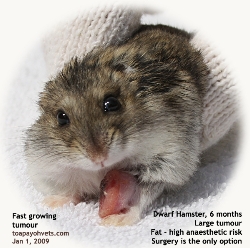 "Will
my hamster die under general anaesthesia?" the career woman
asked over the phone. She had put the hamster in the Surgery
early in the morning and had gone home. "Will
my hamster die under general anaesthesia?" the career woman
asked over the phone. She had put the hamster in the Surgery
early in the morning and had gone home.
"There is always a risk," I noted that her hamster, though
only 6 months old, was as rounded as a sumo wrestler. "No
vet can guarantee that the hamster will never die on the
operating table. The tumour is so big and therefore the
hamster will need a longer anaesthetic time."
The lady would phone me back as she had to think again. Why
didn't she get the tumour removed when it was very small?
She was busy in her career. The tumour just grew very fast.
Today was the last day of 2008 and I had hoped to work half
day. I did not want to suffer from "karoshi" or death from
overwork. Yet there seemed to be more cases in the
afternoon. A cat came in for spaying and now this hamster
with a big hand tumour.
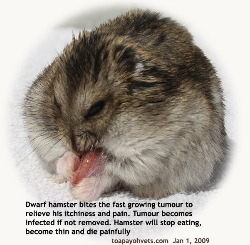 The
lady phoned to give permission to proceed with the surgery
but I could not do it immediately. She came with her husband
at 4 p.m. when I had completed my consultations. "Your
assistant said that the hamster is quiet," the lady was
worried that today was not the appropriate time for surgery.
She had also reduced his food intake. The
lady phoned to give permission to proceed with the surgery
but I could not do it immediately. She came with her husband
at 4 p.m. when I had completed my consultations. "Your
assistant said that the hamster is quiet," the lady was
worried that today was not the appropriate time for surgery.
She had also reduced his food intake.
"You hamster looks normal and behaved normally," I had
observed this hamster in the morning when I took some
pictures on a sunny morning. Bright sunlight gives me
excellent pictures. The hamster was running around on the
table making it hard to snap good pictures of his tumour for
review. Hamsters are usually quiet in the day time as
they are nocturnal animals. But in Singapore, they seem to
be active anytime. So are they nocturnal animals or not?
"There must be no further postponement of the surgery as the
tumour grows so big. The hamster has bitten it off and it
has become infected at its centre - see the black hole in
the centre of the tumour.
The lady and her husband were aware of the black necrotic
spot in the centre of the bitten off tumour.
"It is very painful for the hamster to have a
bleeding and raw flesh in his left front leg. He needs the
front legs to groom himself and now he cannot do a good job
with such a large lump of tissue on his left hand.
"I will try to shell out the tumour and stitch the skin
wound. If the hamster bites off the stitches, he will have a
very big hole in his foreleg and it will become infected
badly."
Today could be the last day of life for this hamster if he
dies on the operating table. Though he was young, he was
very fat. I was not keen on this type of high risk surgery
as I needed a longer time to remove this massive tumour that
extended over 3/4 of the length of his left hand. The last
day of 2008 could be the last day of living for this gentle
hamster. The lady apologised to me as she wiped tears off
her eyes with a piece of tissue paper. She had
consulted Vet 1 around one month ago and did not go for the
surgery option. "Vet 1 asked his assistant to handle the
hamster," she said. "He did not look competent."
I am not surprised that a pet owner judges a vet's
competence by his non-handling of the pet. There was a pet
shop operator and groomer who assessed that I was afraid of
dogs as I muzzle some of them prior to examination to
prevent dog bites onto my fingers. How can I perform surgery
with nasty septic and deep bite wounds from the fangs of pet
dogs? They are extremely painful. But some lay people assess
veterinary competency as if vets can just look into the eye
of the four-legged patient and command their obedience and
submission.
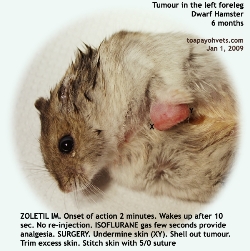 Sometimes
I do ask my assistant to take the hamster out. After all,
what are assistants employed for if not to help out the
veterinarian? In any case, they need the hands-on
experience. Sometimes
I do ask my assistant to take the hamster out. After all,
what are assistants employed for if not to help out the
veterinarian? In any case, they need the hands-on
experience.
My Myanmarese assistant Mr Saw would always put on a white
glove to protect himself from being bitten before holding
the hamster for me. This time I took out the hamster as I
assessed this 6-month-old to be a gentle dwarf hamster and
to save my assistant some worries. So the working couple
must have given me their thumbs up for hamster competency.
"Hamsters do give nasty nips to our hands," I said to the
working couple. I did not mention that I do ask my
Myanmarese vet assistant to take out the hamster sometimes.
How are assistants going to learn if they don't touch any
hamster and get bitten sometimes?
Vets are supposed to be brave-hearted. Only yesterday, my
associate got bitten by a Jack Russell. A 10 cm bite wound
with yellow iodine on his left forearm figured prominently.
A one-year-old Shih Tzu just suddenly snapped at my fingers
after I examined him for ticks.
ANAESTHESIA
Removal of this massive tumour would be very painful.
Therefore the hamster needed a sedation by injection into
his backside muscle. The danger lies in this injection. It
may kill the hamster and that would be the end. Exactly how
much to give is a matter of experience rather than a matter
of weight related dosage as in the dog and the cat. I gave
this hamster a very small dose of Zoletil IM. After 2
minutes, he staggered and fell to his side. Within 60
seconds, he woke up and walked about upright.
Then I put him inside a small see-through anaesthetic
container and gave him 5% isoflurane gas for less than 60
seconds. Hamsters don't show good signs of anaesthesia
unlike dogs. So, it was a matter of observation. With
Zoletil sedation, it would be too hard to see the eyelids
closing. Therefore around 30 seconds of the gas would do.
Top up with gas when the hamster felt the pain. The surgery
and stitching lasted around 10 minutes. The hamster did not
feel any pain as Zoletil was an effective analgesic.
SURGERY
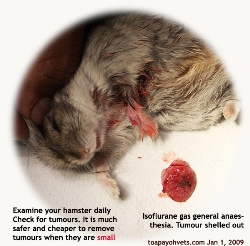 As
this hamster was young, his skin was in good condition. I
used the sharp pointed ophthalmic scissors to cut the tumour
at the split skin edges. Then I undermine the skin and
lifted out the fatty tumour. The skin was stretched by the
big size and had ruptured at half way round the tumour.
Bleeding was controlled bys pressure swabs.
In this case, the tumour was shelled out. There was excess
skin now. I trimmed off the extra skin and put in 5 stitches
of 5/0 absorbable sutures. As
this hamster was young, his skin was in good condition. I
used the sharp pointed ophthalmic scissors to cut the tumour
at the split skin edges. Then I undermine the skin and
lifted out the fatty tumour. The skin was stretched by the
big size and had ruptured at half way round the tumour.
Bleeding was controlled bys pressure swabs.
In this case, the tumour was shelled out. There was excess
skin now. I trimmed off the extra skin and put in 5 stitches
of 5/0 absorbable sutures.
BITING OFF THE SUTURES
The lady was concerned and asked whether I could use an
Elizabeth collar. She was worried about the hamster biting
off the stitches. I used a piece of paper to make an
e-collar. The hamster appeared angry and used his hands to
get the collar out. After 60 seconds, he pulled it off. I
did not want to stress him further and present a dead pet
after all the successful surgery and anaesthesia. His owners
came soon. "How come he is so awake?" the lady expected a
sleepy pet. "Hamsters given minimal sedation and gas
anaesthesia recover very fast," I said. There was no need to
give an antidote. For hamsters, the less injections the
better.
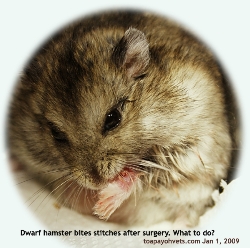 "How
about antibiotics after surgery?" the lady asked. "Vet 1 had
given two types but he hates the pinkish one." Well, I
administered the pink syrup to the hamster via a syringe as
I held the hamster's head. He struggled and really spitted
it out. It must be a joyful New Year's eve for the working
lady as she was the caregiver. She would stay at home for
the next 3 days to ensure that the hamster did not bite off
the stitches. But could she be awake for 24 hours?
Maybe the hamster would also sleep while she sleeps. If the
hamster did not bite off the stitches, there would be good
healing. As at 48 hours after surgery, the owner did not
phone me. I presumed that she was doing a good watchdog job. "How
about antibiotics after surgery?" the lady asked. "Vet 1 had
given two types but he hates the pinkish one." Well, I
administered the pink syrup to the hamster via a syringe as
I held the hamster's head. He struggled and really spitted
it out. It must be a joyful New Year's eve for the working
lady as she was the caregiver. She would stay at home for
the next 3 days to ensure that the hamster did not bite off
the stitches. But could she be awake for 24 hours?
Maybe the hamster would also sleep while she sleeps. If the
hamster did not bite off the stitches, there would be good
healing. As at 48 hours after surgery, the owner did not
phone me. I presumed that she was doing a good watchdog job.
|